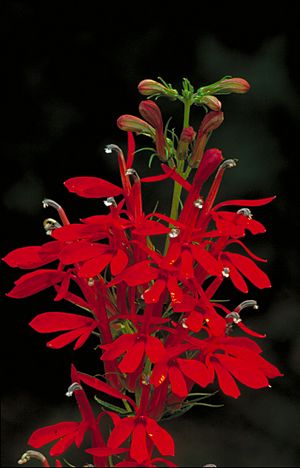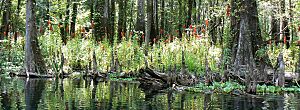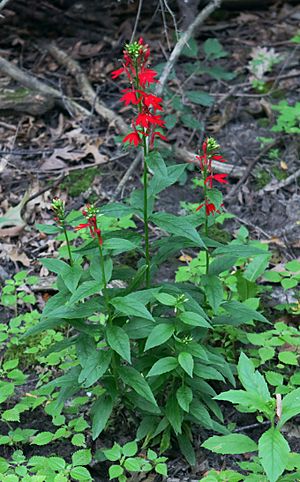Cardinal flower facts for kids
Quick facts for kids Cardinal flower |
|
|---|---|
 |
|
| Conservation status | |
| Scientific classification | |
| Genus: |
Lobelia
|
| Species: |
cardinalis
|
The cardinal flower (Lobelia cardinalis) is a beautiful flowering plant. It belongs to the bellflower family, called Campanulaceae. This plant grows naturally across a large area. You can find it from southeastern Canada all the way south through the eastern and southwestern United States. It also grows in Mexico, Central America, and northern Colombia.
Contents
What is the Cardinal Flower Like?
The cardinal flower is a type of plant called a perennial herbaceous plant. This means it lives for more than two years and has soft, green stems instead of woody ones. It can grow quite tall, up to about 4 feet (1.2 meters). You usually find it in wet places. This includes along streambanks and in swamps.
Its leaves can be up to 8 inches (20 cm) long and 2 inches (5 cm) wide. They are shaped like a spear and have jagged edges. The flowers are usually a bright, fiery red color. Each flower has five deep lobes and is about 1.5 inches (4 cm) wide. They grow in a tall, upright cluster called a raceme. This cluster can reach up to 2.3 feet (70 cm) tall. The flowers bloom from summer into fall. Sometimes, you might even see rare forms with white or pink flowers!
The cardinal flower is related to other Lobelia plants in the eastern United States. Two common relatives are Lobelia inflata and Lobelia siphilitica. All these plants have a special "lip" petal near the flower's opening. They also release a milky liquid if you break their stems. Lobelia siphilitica has blue flowers and is mostly pollinated by bees. But the bright red cardinal flower is mainly pollinated by the speedy ruby-throated hummingbird.

Why is it Called "Cardinal Flower"?
This plant was brought to Europe in the 1620s. By 1629, people were already calling it the "cardinal flower." This name likely came from its color. The vibrant red flowers look very similar to the bright red robes worn by Cardinals in the Roman Catholic Church.
How to Grow Cardinal Flowers
If you want to grow cardinal flowers, they need special care. They like rich, deep soil that stays moist all year round. A special type of cardinal flower called 'Queen Victoria' is very popular. It has even won an award for being a great garden plant!
It's easy to grow new cardinal flowers. You can plant their seeds. You can also divide the small new plants that grow around the older ones each year. Even though they are perennials, they might not live for many years in one spot. They prefer moist soil and a little bit of shade.
Traditional Uses
Some Native American groups have used the cardinal flower for different purposes. The Zuni people used parts of this plant in special "schumaakwe cakes." They also used it on the skin to help with pain from rheumatism and swelling.
Is it Safe?
The cardinal flower is part of the Lobelia group of plants. Because of this, it is considered to be potentially harmful if eaten. It contains natural chemicals called alkaloids, like lobelamine and lobeline, which can be toxic. If someone eats a large amount of the plant, they might feel sick. Symptoms can include feeling nauseous, throwing up, diarrhea, and feeling very tired or weak. It's always best to be careful and never eat wild plants unless you know they are safe.
See also
In Spanish: Cardenala encarnada para niños



